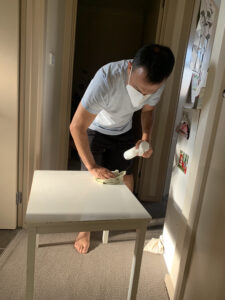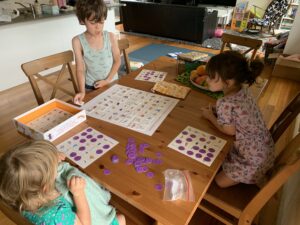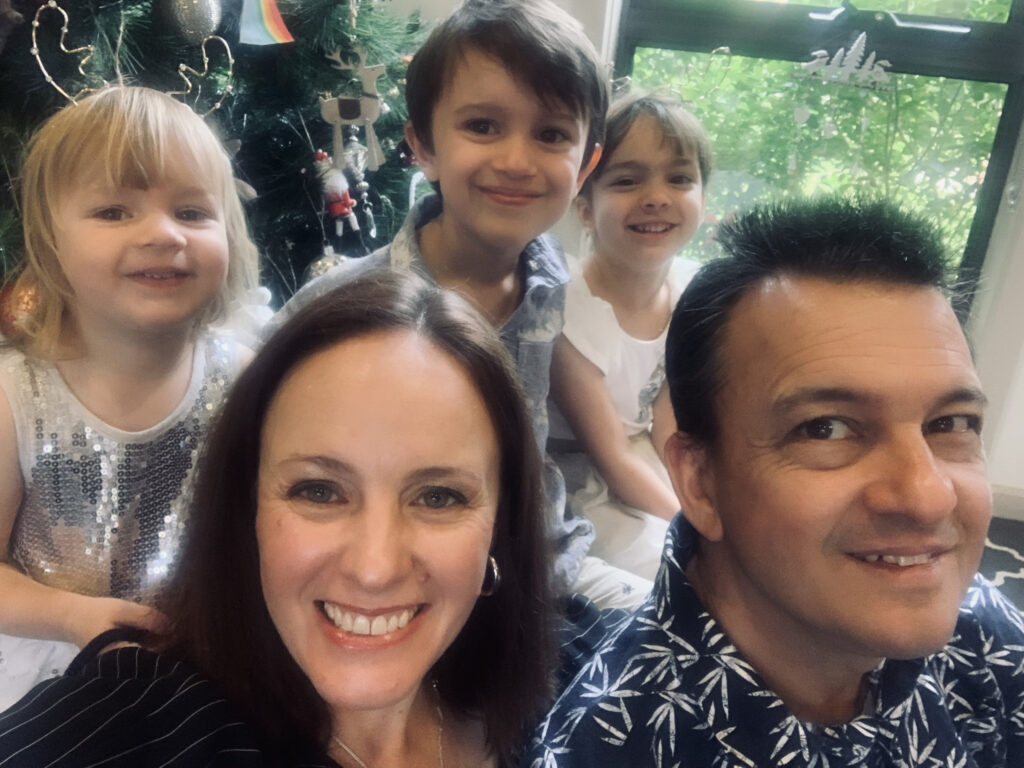Here at the 50/50 by 2030 Foundation, one of our key pillars when it comes to gender equality is “share the load.” In this personal diary, veteran journalist and dad Mark Tamhane describes the nitty gritty of dealing with three young kids with Covid when neither parent had the virus. (Read on for tonnes of helpful advice too!)
If you have children, there‘s more than a strong possibility that you or your family will come into contact with Covid in the days and weeks ahead – if you haven’t already.
As my family and I found, it can be a stressful and confusing time. You’ll be bombarded with bewildering and often seemingly contradictory rules, plenty of advice – much of it totally impractical – and offers of assistance – some of which will not materialise.
More often that not, like us, you’ll end up relying on gut instinct, a bit of common sense, and the kindness and generosity of friends, family and Good Samaritan strangers to navigate Covid.
So what did we learn?
TESTING 1,2,3….
We’d been on tenterhooks for several days, after we were informed in late January that our daughters – 4-year old Charlotte and 3-year old Grace – had been close contacts of a confirmed Covid case at their kindergarten in Melbourne’s north.
The current Victorian government advice is to test and isolate only if you display symptoms, so the girls and their elder brother Jack, spent several days enjoying a burst of hot weather, swimming and splashing in their grandparents’ pool.
One Saturday afternoon Grace emerged from the pool. Her voice sounded hoarse and she was coughing. We thought she may have swallowed some water and put it down to the chlorine and the fact she’s asthmatic

Mark and Emily had to make sure surfaces were constantly wiped down.
But the next morning the cough was back and it was a croupy-sounding bark. Quite unusual in the middle of summer.
We had three rapid antigen tests in the house that I’d bought several months ago, before they became as rare as hen’s teeth, so we decided to use one to swab Grace.
FOG OF WAR
Even though my wife – ABC journalist Emily Bourke – had been watching numerous Twitter videos of how to take a sample from young children without causing discomfort, it was clear that swabbing a cranky and feisty three-year-old was going to require a quasi-military operation, with me holding Grace tight on my lap and clutching her arms, while Emily tried to get a usable swab.
There was plenty of crying, spluttering and sneezing – and Emily and I were resigned to the fact that if we hadn’t already been exposed to airborne droplets containing the virus, we were now pretty much surrounded by a Covid cloud.
Almost as soon as I put Grace’s swab solution into the RAT test cassette, it became clear that she was positive.
WIND IT DOWN, WIND IT UP
As household contacts we were now obliged to get tested, so we all piled into the car and drove down the freeway to the Royal Children’s Hospital. Emily and I donned N95 masks in a vain attempt to keep more Covid out of our airways. I wound down all the windows – much to the kids’ delight – in an effort to keep fresh air circulating, as the experts tell you to do.
Of course that fresh air manoeuver was doomed the moment we got to the RCH’s testing site in the basement of a car park, where the first thing the traffic controllers tell you to do is to wind up your windows.
As Grace had returned a positive result on a RAT test, which we had officially registered on the Victorian Health Department’s website, she wouldn’t need to get tested again. One small mercy….
The rest of us were swabbed for PCR tests and two friendly nurses offered what they understood to be the latest advice about follow-up testing and isolating requirements for positive Covid cases and household contacts.
Possibly the most reassuring thing was when one said, “Oh, I had Covid ten days ago and here I am back at work.”
GET OUTTA MY CLOUD
When we got home, we realised that it was going to be impossible to separate Grace from her siblings, or from us.
Emily is in an online chat group with some medical professionals and one – who doesn’t have children – counseled us to put Grace in a tent by herself away from everyone else in the household.
The suggestion – that we should ask an assertive three-year old, who’s usually inseparable from her brother and sister, to stay in a tent in a tiny concrete back yard in 35 degree summer heat – was so ludicrous that we burst out laughing.
We recalled what a Portuguese acquaintance, who’d had Covid rip through her household, told Emily, “How can you leave your children if they have Covid? They need your love!”
As Grace yelled from our windowless toilet that she needed a hand with a “Number 2”, I smiled to myself as I remembered an interview I’d heard with infectious disease expert Professor Raina MacIntyre, explaining in great detail the risk of fecal transmission of Covid, and how patients should try to use a different bathroom from other members of their household, and how they should flush only after lowering the toilet lid.

Two of the kids (the girls) have covid in this picture…Emily says “Try separating them at the best of times!” From left to right: Jack, Grace and Charlotte Tamhane.
POSITIVE NEGATIVITY
Not long after, our phones started dinging with text messages from the Pathology Unit at RCH.
Charlotte – who shares a bedroom with Grace – had returned a positive test. Much to our surprise and relief – given the kids had been all over us for days – Emily and I were both negative. There was no message with a result for Jack.
Grace had well and truly stopped coughing by now, but we noticed she was a little more whiny than usual. We gave her some panadol for good measure. Charlotte said she felt fine and neither of the girls had an elevated temperature.
Emily began to be bombarded with emails with surveys from a leading children’s health institute and notifications that the children had been enrolled in a Victorian government “Pathways” program to help us navigate Covid. She was told a nurse would call her shortly to help with health advice and outline our isolation requirements. Three weeks later, we’re still waiting for that call.
With five of us living in a small house, we decided it would be nigh on impossible to try and isolate from each other – we’d just have to make do the best with what we already had.
CLEARING THE AIR
About two years ago, we’d bought a HEPA air filter from Officeworks when Melbourne was engulfed in a haze of bushfire smoke. We’d purchased it largely to help Grace with her asthma, but it became a useful tool when Emily and I were both working at home in the winter of 2020, when several of our inconsiderate neighbors decided they’d keep warm by burning off household rubbish and wet wood.
I put the portable air filter as close as I could to the two girls, moving it around the house as they played in the livingroom, then their bedroom when they slept and back to the living room for daytime play.

Air monitors can be useful to show areas when air is stagnant and there are high concentrations of CO2 from people exhaling. Mark and Emily relied on this device a lot!
I also opened as many windows as I could, even though it was absolutely boiling outside. To compensate, I cranked up the airconditioner and an old portable air cooler to provide some relief from the heat. No doubt our next power bill will be huge.
A medical contact of Emily’s had sent her a carbon-dioxide monitor some time ago, ironically after being impressed by a major series of stories she’d done for ABC News on the airborne transmission of Covid. These monitors show areas when air is stagnant and there are high concentrations of CO2 from people exhaling. (CO2 monitors also have a tendency to go bananas from all the water vapour in the air, when you boil up a big pot of rice or pasta!)
I kept the monitor near Charlotte and Grace and would open another door or window when the reading began to show over 700ppm.
A couple of years ago, you wouldn’t be able to get a CO2 monitor for less than $200. Now you can pick one up on-line from as little as $40. They’re not essential, but they’re a useful tool in letting you know where the airflow is not great in your house. As the US Environmental Protection Agency has noted, virus particles can “linger in the air” after a Covid positive person has left the room and “they can remain airborne for hours in some cases”.
HIT THE ROOM, JACK
By Day 2 both girls seemed absolutely fine, displaying no symptoms at all, but we still hadn’t received a test result for Jack. I rang the hospital, but they told me not to worry, as test results can take up to 72 hours. I thought it was odd that three out of four people who had their tests taken at the same time had got their results back straight away, and Jack’s were still outstanding.
When we hadn’t heard back after 3 days I rang the hospital again. This time the operator gave me a 1800-number to call. It turned out to be a recorded message, assuring you that as long as you’d provided a mobile phone number, you would get your results. It then automatically disconnected the call.
Worried about Jack, we decided to use the second last rapid antigen test on him. He was still negative.
But on Day 5, he woke up complaining of a headache and kept bursting into tears for no obvious reason. We used the last test and sure enough, he too had now contracted Covid.
Reluctantly, we separated Jack from us and the girls. He largely spent the next five days in his room. This was actually heaven for him, because he got to play his favourite computer games and view whacky YouTubers without being bothered by his annoying sisters and pesky parents telling him he’d had too much screen-time.
But when darkness fell, we’d lie awake in bed listening out for every little cough or rustle from down the hallway.
Emily would check on him from time to time and find him bathed in sweat, but he’d have pulled the covers tight around him like it was a freezing cold night.
And then the inevitable questions would race through your mind; “How come he has a fever when the girls didn’t even break into a sweat?”, “What if he’s one of the kids that doesn’t make it?”

Sometimes it was hard to keep three sick kids occupied at home.
THE MASKED SINGER
I kept Jack’s bedroom door and windows open for air flow, with the air filter propped just inside his doorway. I perched the CO2 monitor on a bookshelf outside his door and would open more adjacent doors and windows if it crept up over 550 ppm.
We loosely based this set-up on the experience of Melbourne ENT surgeon Eric Levi, who’s tweeted about how his family dealt with a Covid positive teen, who was too young to properly isolate from the rest of his family.
I would use a mask around Jack when I was in the same bathroom helping him shower and there was plenty of steamy droplets in the air, or when I was tidying or wiping down the table in his room. It was the only time we used masks in the house during our entire Covid encounter.
THE DRUGS DO WORK
Nevertheless, worried that we might not be in a position to look after the kids if we contracted Covid, Emily ran our situation past a leading infectious diseases expert. Given the age of our children, the severity of their illness and the cramped nature of our house, he told her that we’d pretty much done everything we could to reduce our chances of spreading of the virus.
“What I can’t get over”, she texted, “Is how the kids were all over us when they would have been at their most infectious (before displaying any symptoms), but Mark and I haven’t contracted Covid. Could it have something to do with the fact we’ve been double vaxxed and both had a booster just before Christmas?”
“Well..”, came the reply, “it certainly looks like vaccines work!”
QUEST FOR THE HOLY GRAIL
Of course, being three and four, Grace and Charlotte hadn’t been eligible to be vaccinated and seven-year old Jack had only just had one pediatric dose of Pfizer.
One of the rules of being a household contact of a Covid-positive case in Victoria is that you need what’s called a “Day 6 test” to come out of isolation the following day. A bizarre quirk is that even if another member of your household has developed Covid after the original case (as Jack had done), you are still free to end your isolation, provided you are not symptomatic. (I understand this is now the case in New South Wales as well.)
Emily and I were both keen to get our Day 6 tests done, as we were starting to run out of food and were both keen for a bit of exercise. But we had both started sneezing a lot and I was often waking up with headaches, so we were keen to confirm that we both didn’t have Covid.
Emily drove to a large state government testing site a couple of suburbs away. Not only had they run out of rapid antigen tests, they weren’t doing PCR tests at all either. There were no rapid antigen kits at a number of other nearby sites or any for sale in a number of local chemists she tried. In fact she was told there “are no more RAT kits in this local government area”. We were told our only hope was to head to Sunshine in Melbourne’s west or Burwood in the eastern suburbs.
THE KINDNESS OF STRANGERS
Emily shared her despair with her online medico pals, and to our amazement, one offered to drop off spare tests to us. Caro – a nurse who works in a ward with Covid-positive patients – had never met Emily in person before, but she drove from the other side of Melbourne, armed not only with 6 RAT kits, but also with bags of presents for the kids – an extraordinary act of generosity.
Again, Emily and I both tested negative, figuring our sneezing and headaches must have been hay fever brought on by having windows and doors open all the time in hot and windy weather.
Not able to go out, we filled the days by watching old Harry Potter movies, doing some kid-friendly jigsaw puzzles a close friend dropped around, and endless rounds of Minecraft and other online games.
Emily’s cousin dropped around some donuts and home-made salads and some toys for the children.
Luckily, we’d done a big shop in the days before Grace tested positive, but we still needed Emily’s mum to get us fresh milk and bread. She was able to do that until she got stuck in isolation too, after her partner – who’d spent time playing with Grace the previous weekend – tested positive.
AND IN THE END…
Despite being largely holed up for what turned out to be more than 10 days at home in stifling heat, Emily and I consider ourselves lucky. So far our girls appear to have been unaffected by contracting Covid, while Jack’s mild symptoms were easily treatable with kids paracetamol and ibuprofen. He ended up missing just three days of school, and while he seems to get tired more quickly than before, he’s 90% back to normal.
We’re both still amazed – but also grateful to medical science – that a combination of vaccination and a few simple – but effective – changes to the way we run our house meant that we were able to avoid Covid – and avoid a parent’s worst nightmare; being incapacitated and unable to look after your kids.

Emily, Mark and their three kids survived the ordeal.
- Feature image at top: Mark, left, with Jack, Grace and Charlotte . Picture: Supplied.
Mark Tamhane is a senior broadcast journalist who writes about parenting. A former ABC London correspondent, he’s also a father of six. Mark lives in Melbourne with his wife, journalist EmIly Bourke, and their three young children.





